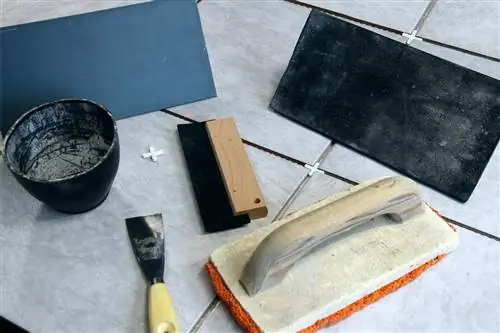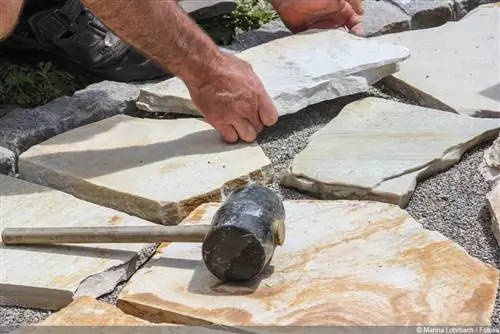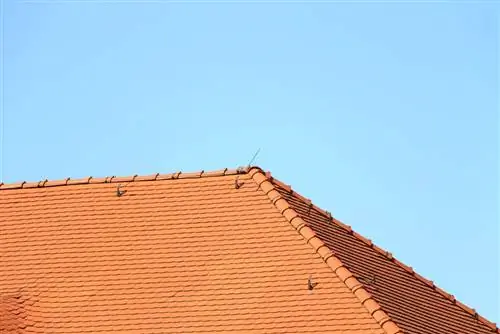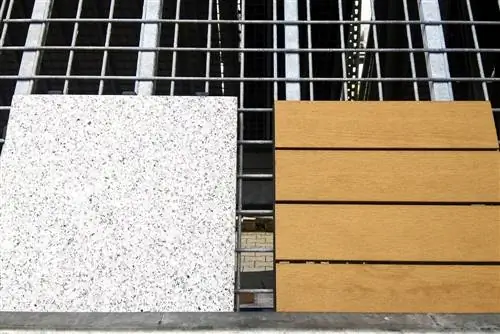- Author admin [email protected].
- Public 2023-12-17 03:39.
- Last modified 2025-06-01 06:48.
Tiles are robust and insensitive. This is precisely why they are particularly popular on the balcony. However, the joy of them only lasts if they are laid correctly.
The underground as a basis
Of course there are balconies made from a wide variety of materials. However, laying tiles is not possible or at least common with every material. We therefore assume that the covering is to be applied to a classic concrete balcony. A reinforced concrete slab is probably the most common variant of a balcony and is particularly often tiled because of its unsightly surface.
Note:
Wooden or steel balconies cannot be sensibly covered with ceramic tiles. In addition, the base materials are generally of very high quality in terms of their surface and are not covered with other covering materials.
Earthenware
When people talk about tiles, they usually mean coverings made of earthenware or stoneware - i.e. classic ceramic tile coverings. They can be laid using several methods.
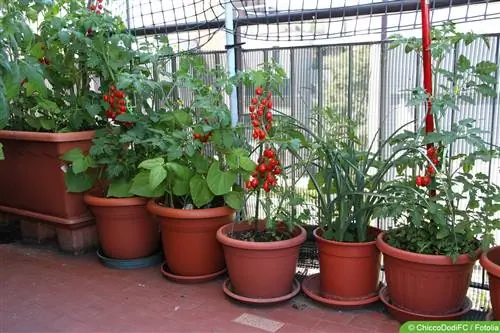
Variant 1 - earthenware in a mortar bed
For centuries, tile coverings have been laid directly into a bed of mortar on a stable, solid surface. The technology remains the same. Only the mortar thicknesses are becoming ever thinner due to ever more powerful cements.
Construction from top to bottom:
- Tile, cement grouted
- Mortar bed, applied with a notched trowel
- Burning barrier (applied as an aqueous solution)
- Load-bearing concrete balcony slab, cleaned and freed from loose dirt
Advantages:
- Low installation height
- Consistently the same cement-based materials
- High pressure resistance
Disadvantages:
- Hardly any flexibility with deformations etc.
- Susceptible to vapor pressure, e.g. moisture in the load-bearing component
- Can only be used on very flat surfaces
NOTE: A structure with organic adhesives looks the same when glued directly. Only the binder of the adhesive differs and relies on organic compounds made from various resins instead of cement.
Variant 2 - earthenware on a separating layer
In order to absorb the susceptibility to steam pressure from the concrete component, modern bonding of stoneware tiles is usually supplemented with an additional layer - the separating layer. This layer dissipates water vapor and prevents the tile covering from being pushed out of the adhesive bed from the “inside”.
Construction from top to bottom:
- Tile, waterproof grouted
- Mortar bed, applied with a notched trowel
- Separation layer (vapor compensation layer), glued flat to the substrate
- Burning barrier (applied as an aqueous solution)
- Load-bearing concrete substrate, cleaned and freed from loose dirt
Advantages:
- Very durable
- Resistant to vapor pressure from the supporting component
- Also suitable for roof terraces etc. with underlying use (interior)
Disadvantages:
- High installation height
- High material, financial and time expenditure
Tiles made of wood or plastic
As an alternative to “real” tile coverings, tiles, i.e. small-scale slab coverings, made of wood or even plastic are increasingly being offered today. However, these products are usually not a new water-bearing level, but “just” a visible and walking surface that is laid on the technical surface as a support and water drainage level.
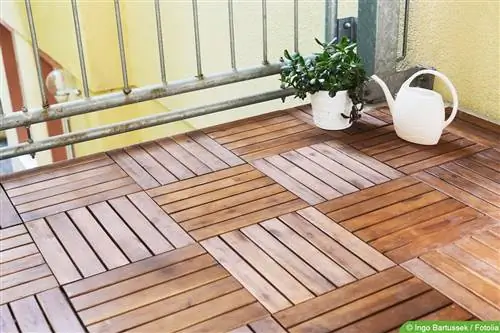
Variant 3 - floating installation
The panel coverings with a wooden or plastic surface can be laid floating on the balcony slab without any mechanical fixation. The individual elements are either just pushed close together or connected via a click system or other connecting means.
Advantages:
- Easy execution
- Low effort
- Simple, non-destructive dismantling
Disadvantages:
- Can only be implemented on very flat surfaces (otherwise offsets and tripping hazards)
- Frequently rattling, slipping, etc. due to small bumps
- Large installation height thanks to spacers between the individual elements to the floor (water drainage)
Variant 4 - glued
A slightly higher quality version of these individual covering elements with a wooden surface or plastic top layer is gluing them to the substrate. In contrast to ceramic coverings, no flat bond is achieved. Instead, individual tile elements are fixed to the floor with double-sided adhesive tape to prevent slipping or shifting.
Advantages:
- Effective securing of the position of loose elements or groups
- Low material costs
- Very simple implementation
- Easy to dismantle
Disadvantages:
- Low durability of the bonds under the influence of sun, cold and moisture
- Loose elements can still be moved and tilted (tripping hazards, rattling noises)
Variant 5 - on substructure
If you want to create an even, more uniform covering surface from the tile elements, you can screw them onto continuous connecting elements made of wooden slats. This means that the entire covering can be applied floating, with the connection to each other providing additional stability against rattling, tipping, etc.
Construction from top to bottom:
- Plastic or wooden tiles, connected to each other using a click system or similar, screwed downwards for each tile element
- Latten made of wooden slats or squared timber, usually one direction is sufficient
- Concrete base, optionally covered with rubber mat or plastic sheet to prevent noise generation
Advantages:
- High dimensional stability
- Effective remedy for tilting or sloping individual tiles
- No intervention in the supporting component with holes, screws etc.
- Cheap alternative with high impact
Disadvantages:
- Very high installation height
- If there are large unevennesses, the covering will creak or bend
Tip:
Loosely laid tile coverings made of wood materials or plastic panels can also be laid on balcony structures other than concrete because they do not interfere with the load-bearing subsurface. This means that the metal plate or even the unsightly tile covering disappears invisibly and yet undamaged.
carpet tiles
The most unusual form of tiles on the balcony are carpet tiles. Previously only found indoors, textile coverings made of synthetic fibers can now be easily laid outdoors because of their moisture and UV resistance.
Variant 6 - stick on flat area
Since carpet tiles have no inherent stability, they must be glued flat to the surface. Otherwise they will slip and wrinkle.
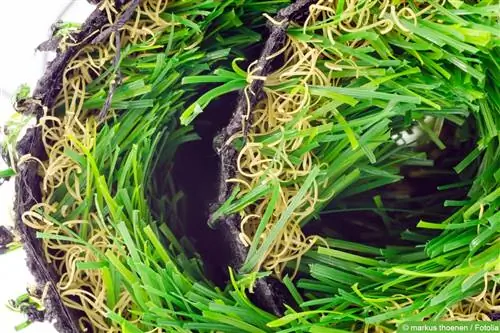
Construction from top to bottom:
- carpet tile
- Adhesive layer made of adhesive suitable for outdoor use, applied or rolled up with a toothed trowel
- Compensation layer against unevenness in the subsurface (for concrete slabs), e.g.: self-leveling casting mortar
- Burning barrier (applied as an aqueous solution)
Advantages:
- Very low installation height
- Easily adaptable to posts, curves and other components
Disadvantages:
- high susceptibility to dirt etc.
- sensitive to vapor pressure from the load-bearing concrete component

